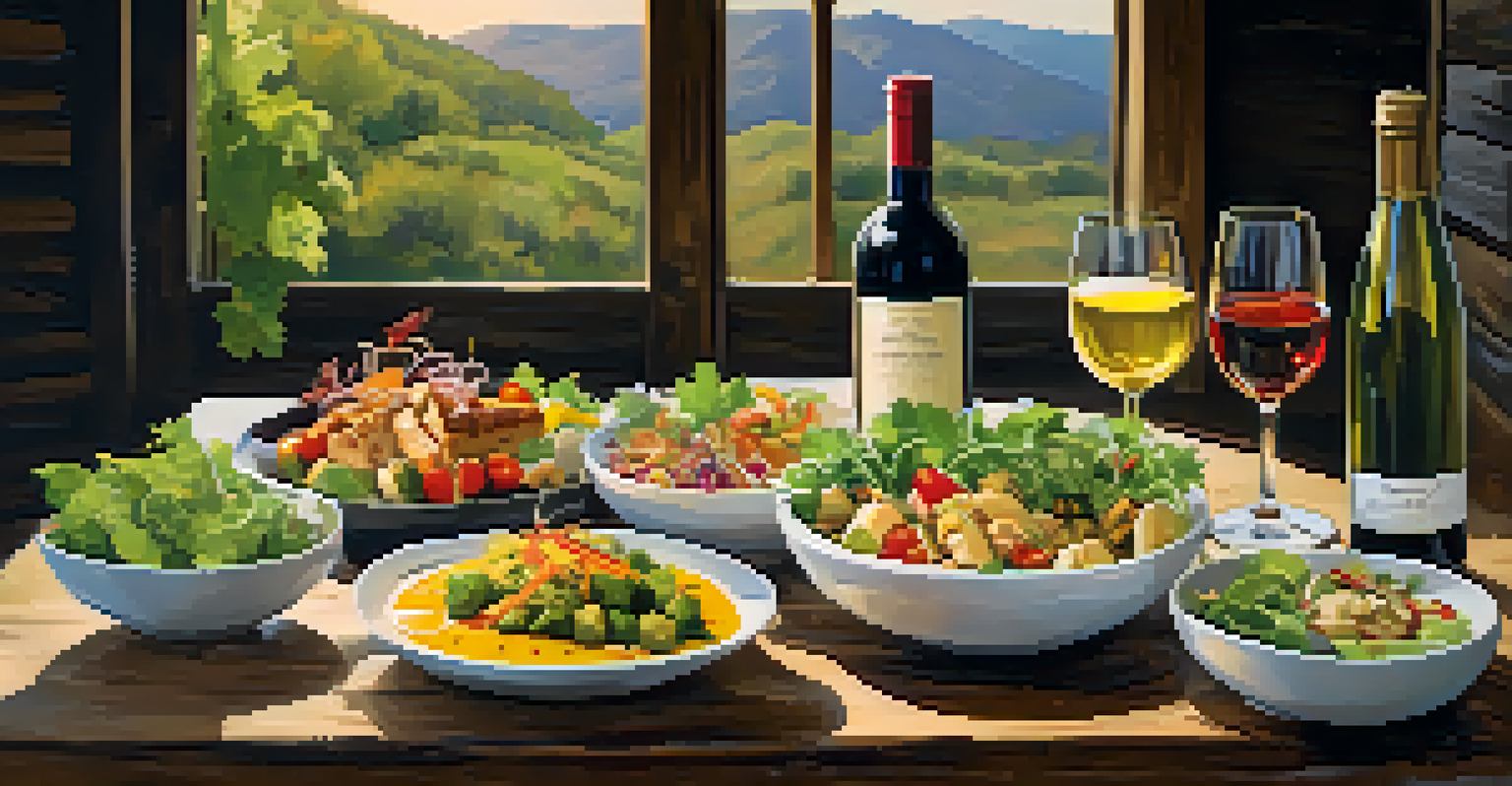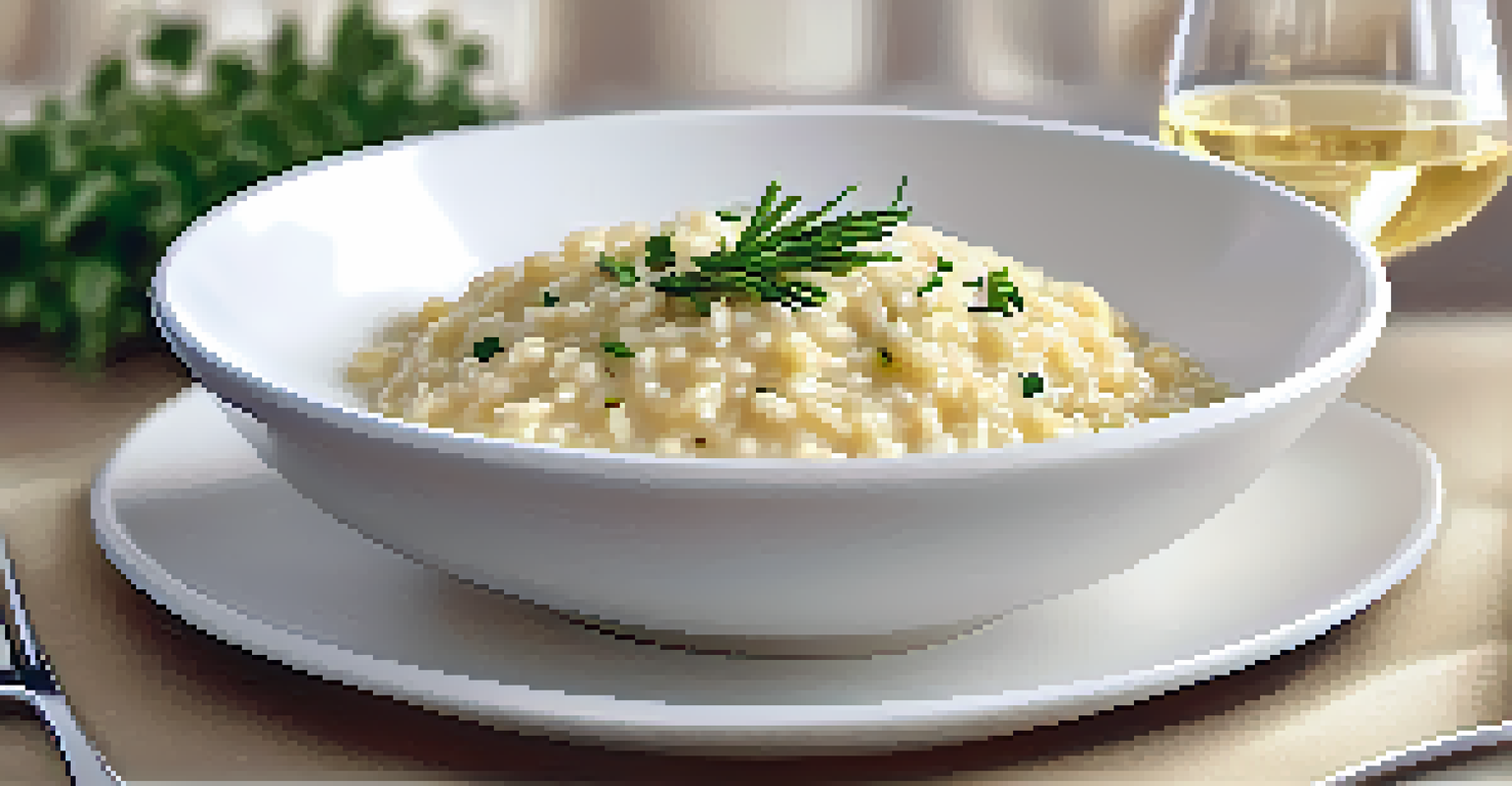Pairing Wine with Food: Elevating the Dining Experience

Understanding the Basics of Wine Pairing
Wine pairing is an art that enhances the flavors of both food and drink. It’s all about finding harmony between the wine’s characteristics and the dish you’re serving. Just like a well-rehearsed duet, when done right, they elevate each other to create a memorable experience.
Wine is sunlight, held together by water.
To get started, consider the main flavor profiles of the dish. Is it rich and creamy, spicy and bold, or light and fresh? Matching these elements with the right wine can turn a simple meal into a culinary masterpiece. For example, a buttery Chardonnay can beautifully complement a creamy pasta dish.
Additionally, think about the wine's body, acidity, and sweetness. A lighter wine, like Pinot Grigio, matches well with salads and seafood, while a full-bodied red, such as Cabernet Sauvignon, pairs nicely with heartier meats. Understanding these basics can set you on the right path to elevating your dining experience.
The Role of Acidity in Wine and Food Pairing
Acidity is a crucial factor in both wine and food pairing, as it can brighten flavors and enhance the overall taste. High-acid wines, like Sauvignon Blanc, can cut through the richness of fatty foods, creating a delightful balance. Think of it as a refreshing splash of citrus on a hot summer day—invigorating and revitalizing.

When choosing a dish, consider how acidity can work for you. For instance, a tangy vinaigrette on a salad can be complemented by a zesty white wine, creating a refreshing contrast. This interplay keeps the palate engaged, making each bite and sip more enjoyable.
Wine Pairing Enhances Dining
Finding the right wine to complement your dish can elevate the entire dining experience.
Moreover, the acidity in wine can also soften the flavors of certain dishes. A crisp Riesling can bring out the sweetness in spicy Asian cuisine, proving that opposites can indeed attract. Embracing acidity in your pairings opens up a whole new world of delicious possibilities.
Exploring Red and White Wine Pairings
When it comes to wine, red and white each have their own unique personalities, which can dramatically influence food pairings. Red wines are typically bold and rich, making them ideal for hearty dishes like grilled meats or stews. Imagine a juicy steak paired with a robust Merlot; it’s a match made in flavor heaven.
Food and wine are not just a pairing; they are a marriage of flavors and experiences.
On the other hand, white wines often bring a lighter, crisper profile to the table. They shine when paired with lighter fare, such as seafood or chicken. For example, a delicate Pinot Grigio can enhance the fresh flavors of grilled fish, allowing the dish to shine without overpowering it.
Ultimately, the choice between red and white can come down to personal preference. Some may prefer the depth of red, while others enjoy the freshness of white. Experimenting with both can lead to delightful surprises and help you discover your own ideal pairings.
The Power of Regional Pairings
A fun and effective way to approach wine pairing is through regional matching. This concept suggests that wines from a particular region often pair well with the local cuisine. Think of it like the perfect dance couple—each knows the other's moves and complements them beautifully.
For instance, Italian wines like Chianti are fantastic with traditional Italian dishes, such as pasta with marinara sauce. The wine's acidity cuts through the richness of the tomato sauce, creating a harmonious flavor profile. Similarly, a crisp German Riesling can elevate a spicy curry, enhancing the dish's aromatic spices.
Acidity Balances Flavors
High-acid wines can brighten the richness of foods, creating a delightful balance.
By embracing regional pairings, you can celebrate the culture and traditions behind both the wine and the food. It’s a wonderful way to explore and appreciate culinary diversity while enjoying delicious meals and wines that are meant for each other.
Pairing Wine with Spicy Dishes
Spicy foods can be a challenge when it comes to wine pairing, but the right wine can elevate the experience. Generally, the key is to choose wines that offer a touch of sweetness to counteract the heat. A slightly off-dry Riesling or Gewürztraminer can be the perfect partner for spicy Asian or Mexican dishes.
For example, when enjoying a spicy Thai curry, a fruity, aromatic white wine can help balance the heat while enhancing the dish's complex flavors. This pairing allows you to enjoy the full spectrum of flavors without overwhelming your palate. It’s like a refreshing breeze on a hot day—inviting and soothing.
Another tip is to avoid high-tannin red wines with spicy foods, as the tannins can amplify the heat, leading to an unpleasant experience. Instead, opt for lighter reds, such as Pinot Noir, which can provide a nice contrast without clashing with the spices. This careful consideration can turn a spicy meal into a delightful adventure.
The Importance of Texture in Pairing Wine
Texture plays a significant role in the wine and food pairing process, as it affects how we perceive flavors. When pairing, consider the body, richness, and mouthfeel of both the food and the wine. For example, a creamy dish goes hand-in-hand with a full-bodied wine, creating a luxurious mouthfeel that enhances the dining experience.
Imagine enjoying a rich risotto paired with a smooth, buttery Chardonnay. The creamy texture of the risotto is beautifully complemented by the wine's velvety finish, making every bite and sip a delight. It's all about creating a harmonious experience that feels just right.
Trust Your Taste Preferences
Ultimately, personal taste is the best guide in wine pairing, encouraging experimentation and exploration.
Conversely, when dealing with a dish that has a lighter texture, such as grilled vegetables, opt for a wine that matches that lightness. A crisp Sauvignon Blanc can provide a refreshing contrast, enhancing the freshness of the vegetables while keeping the overall experience balanced. Paying attention to texture is a game changer in the world of wine pairing.
Experimenting and Trusting Your Palate
At the end of the day, the most important rule of wine pairing is to trust your palate. While there are guidelines and suggestions, your taste preferences are what truly matter. Don’t be afraid to experiment and explore different combinations—after all, the world of wine is vast and exciting.
Try hosting a tasting party with friends where everyone brings their favorite wine and a dish to share. This communal approach allows you to discover new pairings and learn from each other’s experiences. It’s a fun way to expand your palate while enjoying great company and delicious food.

Remember, there are no hard and fast rules in the world of wine pairing. What works for one person may not work for another, and that's perfectly okay. Embrace the journey of discovery and enjoy the process of finding what pairs best with your favorite meals.